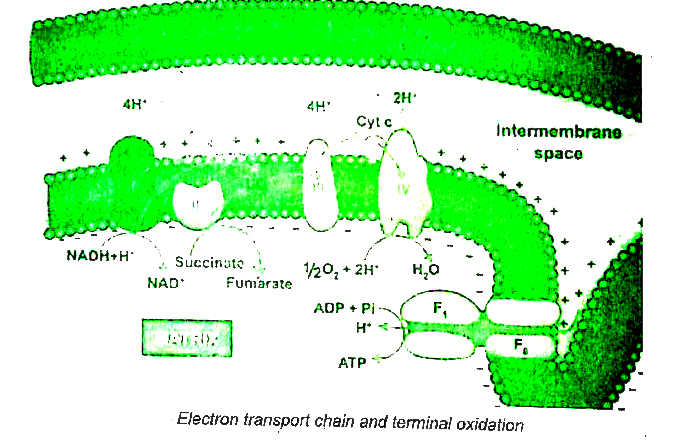What is electron transport chain? Solution in Tamil
During glycolysis, link reaction and Krebs cycle the respirator substrates are oxidised at several steps and as result many reduced coenzymes NADH+H+ and FADH2 are produced. These reduced coenzymes are transported to inner membrane of mitochondria and are converted back to their oxidised forms produce electrons and protons. In mitochondria, the inner membrane is folded in the form of finger projections towards the matrix celled cristae. In cristae many oxysomes (F1 particles) are present which have electron transport carriers are present. According to Peter Mitchell.s Chemiosmotic theory this electron transport is coupled to ATP synthesis. Electron and hydrogen (proton) transport takes place across four multiprotein complexes (I-IV). The are
(i) Complex-I (NADH dehydrogenase: It contains a flavoprotein (FMN) and associated with non-heme iron Sulphur protein (Fe-S). This complex is responsible for passing electrons and protons from mitochondrial NADH (Internal) to Ubiquinone (UQ).
NADH+H+UQ⇔NAD++UQH2
In plants, an additional NADH dehydrogenase (External) complex is present on the outer surface of inner membrane of mitochondria which can oxidise cytosolic NADH+H+. Ubiquinone (UQ) or Coenzyme Quinone (Co Q) is a small, lipid soluble electron, proton carrier located within the inner membrane of mitochondria.
(ii) Complex-II (Succinic dehydrogenase): It contains FAD flavoprotein is associated with non-heme iron Sulphur (Fe-S) protein. from succinate in Krebs cycle and is converted into fumarate and passes to ubiquinone.
Succinate +UQ→ Fumarate+UQH2
(iii) Complex-III (Cytochrome bc1 complex):
This complex oxidises reduced ubiquinone (ubiquinol) and transfers the electrons throgh Cytochrome bc1 Complex (Iron Sulphur center bc1 complex) to cytochrome c. Cytochrome c is a small protein attached to the outer surface of inner membrane and act as a mobile carrier to transfer electrons between complex III to complex IV.
UQH2+2CytC oxidised⇔UQ+2Cytcreduced +2H+
(iv) Complex IV (Cytochrome c oxidase):
This complex contains two copper centers (A and B) and cytochromes a and a3. Complex IV is the terminal oxidase and bring about the reduction of 12O2→H2O. Two protons are needed to form a moleule of H2O (terminal oxidation).
2CytCoxidised +2H++1/2O2⇔2CytCreduced +H2O
The transfer of electrons from reduced coenzyme NADH to oxygen via complexes I to IV is coupled to the synthesis of ATP from ADP and inorganic phosphate (Pi) which is called Oxidative phosphorylation. The F0F1 - ATP synthase (also called complex V) consists of F0andF1. F1 converts ADP and Pi to ATP and is attached to the matrix side to the inner membrane. F0 is present in inner membrane and acts as a channel through which protons come into matrix.
Oxidation of one molecule of NADH+H+ gives rise to 3 molecules of ATP and oxidation of one molecule of FADH2 produces 2 molecules of ATP within a mitochondrion. But cytoplasmic NADH+H(^(+) yields only two ATPs though external NADH dehydrogenase. Therefor, two reduced coenzyme (NADH+H+) molecules from glycolysis being extra mitochondrial will yicld 2×3=4 ATP molecules instead of 6 ATPs. The Mechanism of mitochondrial ATP synthesis is based on Chemiosmotic hypothesis. According to this theory electron carriers present in the inner mitochondrial membrance allow for the transfer of protons (H+). For the production of single ATP, 3 protons (H+) are needed. The terminal oxidation of external NADH bypasses the first phosphorylation site and hence only two ATP molecules are produced per external NADH oxidised through However, in those animal tissues in which malate shuttle mechanism is present, the oxidation of external NADH will yield almost 3 ATP molecules.
Complete oxidation of a glucose molecule in aerobic respiration result in the net gain of 36 ATP molecules in plants. Since huge amount of energy is generated in mitochondria in the form of ATP molecules they are called .power house of the cell.. In the case of aerobic prokaryotes due to lack of mitochondria each molecule of glucose produces 38 ATP molecules. 
Topper's Solved these Questions
- BOOK - PREMIERS PUBLISHERSCHAPTER - RESPIRATIONEXERCISE - CHECK YOUR GRASP! (Textbook Page No. 145)1videos
RESPIRATION
- BOOK - PREMIERS PUBLISHERSCHAPTER - RESPIRATIONEXERCISE - CHECK YOUR GRASP! (Textbook Page No. 156)2videos
RESPIRATION
- BOOK - PREMIERS PUBLISHERSCHAPTER - RESPIRATIONEXERCISE - OTHER IMPORTANT QUESTIONS & ANSWER (Choose the correct answer)35videos
RESPIRATION
- BOOK - PREMIERS PUBLISHERSCHAPTER - REPRODUCTIVE MORPHOLOGYEXERCISE - SOLUTION TO ACTIVITY1videos
REPRODUCTIVE MORPHOLOGY
- BOOK - PREMIERS PUBLISHERSCHAPTER - SECONDARY GROWTHEXERCISE - OTHER IMPORTANT QUESTIONS & ANSWERS (IV Answer in detail.)6videos
SECONDARY GROWTH
Similar Questions
How many ATP molecules are produced from one sucrose molecule?
03:14View SolutionWhy do micro organisms respire anaerobically ?
03:09View SolutionThe term respiration was coined by ________
04:22View SolutionPrepare a diet chart to provide balanced diet to an adolescent (a school going child) which includes food items (fruits, vegetable and seeds) which are non - expensive and are commonly available.
View SolutionDescribe the activity of vascular with the help of diagram.
32:25View SolutionMitochondrial electron transport chain is
02:54View SolutionWhat is electron transport chain?
46:15View Solution…………is not a electron transport chain inhibitor.
02:09View SolutionWhat is Electron Transport Chain ? (ETC).
02:16View SolutionElectron Transport Chain| Respiratory Quotient
04:45View SolutionElectron transport chain is located on
04:03View SolutionElectron Transport Chain
View SolutionWhat is the function of CO-Q in the electron transport chain.
View SolutionWhat is an electron transport chain?
02:25View SolutionWhat happens in the Electron transport chain?
View SolutionThe enzymes for electron transport chain are present
02:50View Solution

